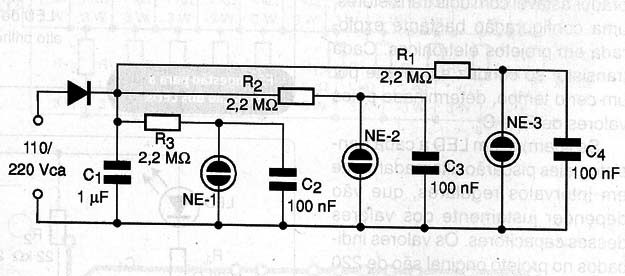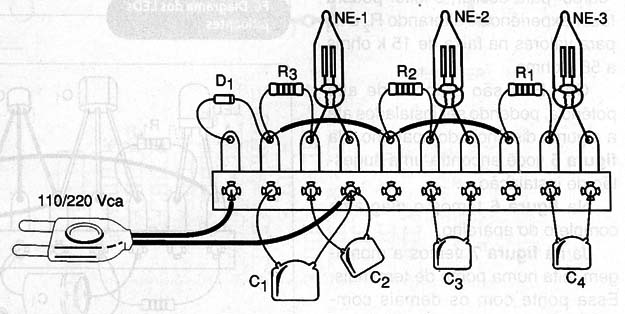Mount a set of neon lamps in a decorative object and turn the circuit from the AC power line of 110 V or 220 V. The lamps will flash randomly with an interesting decorative effect.
The most important of this circuit is the consumption, so low that it can remain permanently connected with no appreciable increase in energy cost. Each lamp consumes less than 0.001 W which is less than 100 000 times a standard incandescent bulb.
The circuit is extremely simple and inexpensive and can be used even scrap components.
The basic idea is to form oscillators with neon lamps in the times of flashes are given by the resistors and capacitors (the reader can change the values ??of the capacitors to change the effect).
All oscillators are powered by a common source of consum is very low with only two components: a diode and capacitor C1.
The circuit power can be made both from 110V line as 220 V without any change in components. In Figure 1 we have the complete diagram of the system for 3 lamps.

We may change the circuit by adding more lamps with no problem. The assembly is done using a terminal strip as shown in Figure 2.

The neon lamps are common and the resistors can be 1/8 to ¼ W. The capacitors C2, C3 and C4 should be polyester types with working voltage at least 100 V. These capacitors can have values between 10 and 470 nF nF, typically.
The capacitor C1must be polyester to 250 V or more if the AC power line is 110 V and 450 V if AC power line is 220 V.
The 1N4004 diode is if the line is 110 V and 1N4007 if the line is 220 V.
An interesting application for this circuit is the Christmas tree decoration. The advantage over commercial types in which the bulbs are in series is that each flasher is independent and if it stops just change the module.
In addition, the oscillators are independent, which means that the lamps flash separately and not in sets as a conventional flasher.
D1 - 1N400 (110 V) and 1N4007 (220 V) - silicon diode
NE-1, NE-2, NE-3 - common neon lamp NE-2H or equivalent
C1 - 1 µF - polyester capacitor - see text
C2, C3, C4 - 100 nF - Polyester capacitors 100 V or more
Miscellaneous:
Power cable, terminal strip, box, wire, weld, etc.



